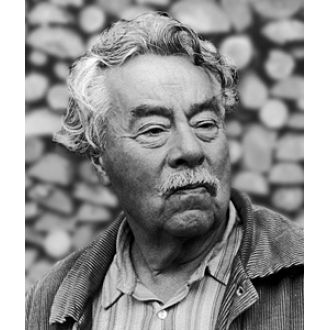Artist
Nikolai Timkov

1912-1993
Leningrad, USSR
graphic artist
Nikolai Efimovich Timkov was born August 12, 1912, at a settlement of Nakhichevanskaya Dacha close to Rostov-on-Don, Russian Empire. His parents, Efim Yegorovich Timkov and Vasilisa Timofeevna Ablyazova were peasants from the Saratov province. In 1892, they moved to Rostov-on-Don. A father worked as a general worker. The family had four older children. Parents died in 1924, when Nikolai was twelve years old. Care of him took the older sisters
In 1927, Nikolai Timkov finished 8 grades of secondary school and enrolled in the Rostov Art College, which was headed by A. Chinenov, who was landscape painter, a pupil of Vasily Polenov and a big fan of Isaac Levitan.
In 1930, Timkov graduated from Art College. In 1931, he went to Moscow, where he met with Pavel Radimov and other Moscow artists of AKhR Association (Association of Artists of the Revolution).
Timkov worked in "Izogiz" edition as a general worker, then enrolled at the Association "Vsekohudozhnik" as an artist-designer. At the same time he taught himself at the Tretyakov Gallery and did much plein air painting, occasionally heeding the benevolent advice of Mikhail Nesterov and Sergey Malyutin. At Radimov's apartment he met Isaak Brodsky, who played a big role in the fate of the artist. After seeing his work, Brodsky advised Nikolai Timkov to go to Leningrad to continue his art education.
In 1933 Nikolai Timkov together with Alexander Laktionov arrived in Leningrad and entered the painting department of the Leningrad Institute of Painting, Sculpture and Architecture of the All-Russian Academy of Arts. He studied with Mikhail Bernshtein, Arcady Rylov, Alexander Lubimov, and Vladimir Serov. In 1939 Nikolai Timkov graduated from the Institute of Painting, Sculpture and Architecture in Isaak Brodsky workshop with the rank of artist of painting. His degree work was a painting titled The Day off in suburb.[4] In one year with Timkov Institute graduates Piotr Belousov, Mikhail Kozell, Lev Orekhov, Aleksei Gritsai, Elena Skuin, Gleb Verner, Lia Ostrova, Boris Sherbakov, and other young artists who later became famous Soviet painters and art educators.
After graduation, Nikolai Timkov was called up for military service in the Baltic Fleet, where he served until 1946. During the Great Patriotic War and Blockade of Leningrad Timkov was among defenders of Leningrad. During brief visits to the city, he created a series of graphic works (gouache, watercolor), depicting the Siege of Leningrad (now in the collection of the State Russian Museum and the Museum of the History of Saint Petersburg). Timkov participated in the Exhibition of the defenders of Leningrad, also in the Exhibition titled "The Heroics of Soviet Front and Rear" in Moscow at the Tretyakov Gallery in 1943, as well as creating the greatest during the war years Exhibition "The Heroic defense of Leningrad", opened in 1944 and marked the beginning of the Museum of Defense of Leningrad. Timkov was awarded the medals "For Defense of Leningrad", and "For Victory over Germany". In 1943, Nikolai Timkov was accepted as a member of the Leningrad Union of Soviet Artists.
In 1927, Nikolai Timkov finished 8 grades of secondary school and enrolled in the Rostov Art College, which was headed by A. Chinenov, who was landscape painter, a pupil of Vasily Polenov and a big fan of Isaac Levitan.
In 1930, Timkov graduated from Art College. In 1931, he went to Moscow, where he met with Pavel Radimov and other Moscow artists of AKhR Association (Association of Artists of the Revolution).
Timkov worked in "Izogiz" edition as a general worker, then enrolled at the Association "Vsekohudozhnik" as an artist-designer. At the same time he taught himself at the Tretyakov Gallery and did much plein air painting, occasionally heeding the benevolent advice of Mikhail Nesterov and Sergey Malyutin. At Radimov's apartment he met Isaak Brodsky, who played a big role in the fate of the artist. After seeing his work, Brodsky advised Nikolai Timkov to go to Leningrad to continue his art education.
In 1933 Nikolai Timkov together with Alexander Laktionov arrived in Leningrad and entered the painting department of the Leningrad Institute of Painting, Sculpture and Architecture of the All-Russian Academy of Arts. He studied with Mikhail Bernshtein, Arcady Rylov, Alexander Lubimov, and Vladimir Serov. In 1939 Nikolai Timkov graduated from the Institute of Painting, Sculpture and Architecture in Isaak Brodsky workshop with the rank of artist of painting. His degree work was a painting titled The Day off in suburb.[4] In one year with Timkov Institute graduates Piotr Belousov, Mikhail Kozell, Lev Orekhov, Aleksei Gritsai, Elena Skuin, Gleb Verner, Lia Ostrova, Boris Sherbakov, and other young artists who later became famous Soviet painters and art educators.
After graduation, Nikolai Timkov was called up for military service in the Baltic Fleet, where he served until 1946. During the Great Patriotic War and Blockade of Leningrad Timkov was among defenders of Leningrad. During brief visits to the city, he created a series of graphic works (gouache, watercolor), depicting the Siege of Leningrad (now in the collection of the State Russian Museum and the Museum of the History of Saint Petersburg). Timkov participated in the Exhibition of the defenders of Leningrad, also in the Exhibition titled "The Heroics of Soviet Front and Rear" in Moscow at the Tretyakov Gallery in 1943, as well as creating the greatest during the war years Exhibition "The Heroic defense of Leningrad", opened in 1944 and marked the beginning of the Museum of Defense of Leningrad. Timkov was awarded the medals "For Defense of Leningrad", and "For Victory over Germany". In 1943, Nikolai Timkov was accepted as a member of the Leningrad Union of Soviet Artists.